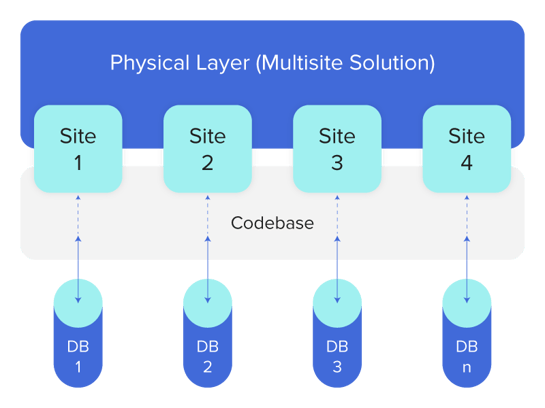Building and managing multiple websites within an enterprise can get really complex, really fast. Slower website builds, higher operational overheads and the lack of scalability, visibility, and control are just some of the challenges.
What enterprises need is a way to streamline and bring order to this chaos. They need to bring standardization, optimal processes, and centralized governance, without impacting the operational autonomy of the different sites.
Enter multisite architecture.
Multisite architecture: A closer look
A multisite architecture essentially involves running different websites on a single codebase. The sites share a set of common resources and standardized elements, while still retaining the independence to manage certain other aspects. The deployment is usually in the form of a centralized platform that offers all the shared resources, defining and maintaining a superset of functionality that provides great efficiencies.

This basic rearrangement with a multisite architecture delivers some major benefits:
- Faster time-to-market: Most multisite architecture deployments have a repository of reusable components that can be quickly put together to create new sites with the required features and functionalities. These components are standardized and created with performance best practices in mind, so every new site across the brand is guaranteed basic consistency and performance.
-
Simplified content management: Easy and seamless editorial workflows are one of the highlights of a multisite architecture. Content created once can be shared across all sites and independent editorial teams can choose to publish it on their sites with a few clicks. Editorial teams are also in sync as they get timely notifications for any changes introduced in the content, without having to collaborate over multiple channels.
- Knocks off the Extra Cost: Having a multisite architecture saves your business the extra cost in a few different ways:
- Eliminates the duplication effort that goes into independent website teams building their sites from scratch. Reusable components and shared resources (server, database, codebase) keep website development costs low.
- Costs like licensing and hosting for each individual site is eliminated.
-
Ensure Brand Consistency: Independent website teams often build websites that look and operate differently, sometimes missing the mark on a consistent brand experience. But because multisite gives you a standard set of modules and themes, or a basic site template to replicate, the user experience across different brand websites can be kept consistent.
-
Easy Maintenance: A common site architecture allows the organizations to add new modules, and update or replace existing modules. With a unified multisite platform, visibility, access, and control of your sites remain streamlined. Easy maintenance ultimately leads to better site experiences for your audience.
-
Upgrade Only Once: Multisite is particularly useful for managing the code since each upgrade needs to be done only once. This saves a lot of time particularly if the number of websites is in double digits.
When do you need a multisite architecture?
There are several scenarios wherein brands manage multiple websites, and would greatly benefit from a unified platform architecture to manage them. Here's a look at why a multisite architecture is what is needed in these cases:
- Different sub-brands: An enterprise with a parent brand site and separate sub-brands ideally want to have a different look and feel for each site. However, there is still a lot of common content that needs to be shared across sites, or a lot of sites need similar functionalities. A multisite architecture is designed to meet those needs while streamlining site management.
- Multilingual and Multi-regional sites: For a global enterprise that wants to showcase a single site in different languages or regions, with maybe minor variations in content, multisite is a perfect choice. Rolling out sites in new languages becomes a matter of days rather than months, and each new site works exactly like the parent site. This also applies to a lot of other business models that need near-identical but separate websites, which can be quickly launched and easily managed with multisite.
- Sites with a lot of content: While your content might be getting the right traction, a single site may not be ready to handle all the traffic, adversely impacting the user experience and site rankings. This is especially true for media sites that have a huge volume of content being published every day. Breaking the content into separate sites, intranet, wikis, all managed on a multisite platform is a more efficient option.
When is multisite not the right option?
While the benefits are distinct, multisite may not be the right solution for every enterprise with multiple websites. Here are a few things to consider, to help you know when a multisite architecture is not for you:
- Distinctly different websites: Multisite runs of the premise that multiple websites within an organization will have things in common. However, if you have individual sites that are completely different from each other - serve different purposes, have no common content or functionalities, visually distinct - then a multisite architecture does not make business sense. These sites are best maintained independently and leveraged to their full potential.
- Heavy expected server load: Because multisite has many sites hosted on a single environment, an unexpected spike in one site may impact the performance of all other sites. So in cases where you want each site to maintain a certain level of uptime and performance, you have to evaluate if you have sites that can see sudden traffic spikes. If yes, then that should not be brought onto the multisite setup.
Opting for multisite is a big decision and hence has to be taken after careful consideration. You can evaluate your business scenario to understand how multisite can be beneficial, or if your operational specifics are not suited to a multisite architecture. We hope the above information helps you take that call.
Once you have made that decision, you can go on to decide if Drupal is the right choice for your multisite, and how to build an effective multisite architecture.
Srijan teams have worked with several global enterprises to deliver multisite architecture with the Drupal multisite solution. We understand the business and technological nuances involved in a large-scale multisite setup and have the expertise to help you successfully navigate the discovery, development, and deployment phases of the project.
Planning to opt for multisite but still have doubts? Join the webinar, where Brian Hibbert, CIO, ICTSI, talks about how they adopted a multisite architecture and the benefits it has delivered.
Our Services
Customer Experience Management
- Content Management
- Marketing Automation
- Mobile Application Development
- Drupal Support and Maintanence
Enterprise Modernization, Platforms & Cloud
- Modernization Strategy
- API Management & Developer Portals
- Hybrid Cloud & Cloud Native Platforms
- Site Reliability Engineering





